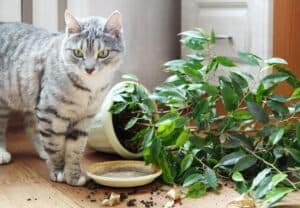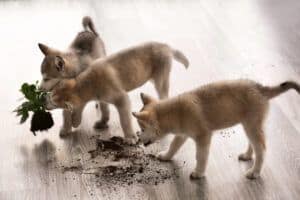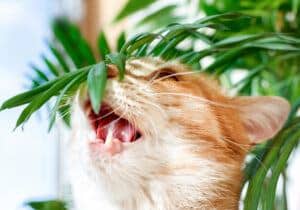HousePlantJoy is supported by our audience. When you purchase through one of our links, we may earn a small affiliate commission. As an Amazon Associate I earn from qualifying purchases. Your cost is not affected.
==================
How to Keep Pets Away from Houseplants
Of course, your houseplants and pets can coexist, but your furry friend isn’t aware of that. For your pets, houseplants are delicious, good-smelling, and easy-to-reach toys that they can play with. My dogs love sleeping on the pot even though they have expensive and comfortable beds. So, how to keep pets away from houseplants?
In this post, I will share some valuable tactics to help you learn how to keep pets away from houseplants!
Houseplants are a great addition to every home as they add colours, keep the air clean, and provide oxygen. However, since our pets are naturally curious creatures and have a mind of their own, they try to get their noses into things they should not—for example, our plants.
Maybe you are tired of stopping your four-legged friend not to dig the soil and uproot your houseplants. Maybe your cat uses your houseplants as a litter box. Or what if you have a poisonous plant in your home? There are various reasons that your houseplants and pets do not mix well. That is why knowing how to keep pets away from houseplants.
Why Do Pets Chew Houseplants Anyway?
Here are some common reasons that your lure your pets to get their noses into your houseplants:
· Taste of the Plants
Much of the pets’ exploration starts through their mouth. This is especially true for cats. It may not sound much enticing to you, but even a newborn baby experience things for the first time in the same way. As newborns put everything in their mouths, most pets do the same. If they like the taste of your houseplant, it is safe to say that your pet will go back for more.
Even if you have non-toxic plants, you will want to notice how they are chewing off. Some non-toxic plants can also cause nausea, vomiting, upset stomach, etc.
· The texture of your Houseplants
When taking your pets for a walk, you may notice that they will instantly attract reeds of grass and start gnawing on them. It is because they like the texture of the plant. Or, it is also possible that your pet has an upset stomach and is trying to get more fibre to help move the things in their gastrointestinal tract.
· Movement of Leaves
Another most common reason that makes it difficult to keep pets away from houseplants is the movement of plant leaves. The movement of leaves, especially for cats, is nearly impossible to resist. Some houseplants that have long soft leaves can easily attract your pets.
· Boredom
Boredom is probably the number one reason that can make it difficult to keep pets away from houseplants. Leaving your four-legged friend to him or herself for more extended periods can make them act weirdly, and one of those can be aggressive behaviour. As a result, your pet may start knocking off your houseplants along with other household items.
How to Keep Pets Away from Houseplants?
Here are a few tactics that you can try to keep pets away from houseplants:
1. Keep Your Houseplants Out of Reach
One of the quickest ways to keep pets away from houseplants is to keep them somewhere safe where they aren’t accessible to your pets. For instance, using plant stands are a great pet deterrent for the little ones if you have a guinea pig or a small dog.
But if you have a big pet and can easily reach the plant stand, you can consider hanging planters or tall furniture to prevent your pet from knocking off your plants. However, if you have a cat that can easily climb even on the tallest furniture, you will need to think even more significantly.
2. Move the Plants Where Your Pets Aren’t Allowed
Do you have rooms that are off the limits of your pets? For instance, some people have their pets trained to stay in the kitchen. It is an excellent way to keep pets away when cooking and prevent them from getting their noses on what they should not eat.
Maybe you have already reserved a separate sleeping place for your pets, so they do not enter you’re your bedroom. In that case, you can keep the pets away from houseplants by keeping plants in your bedroom. You can have plants in your bedroom that purify the air. However, what if your four-legged friend follow you throughout your home?
3. Train Your Pets
You can efficiently train your pets to use the litter box when they want to go to the bathroom. If you’ve already done that, you can easily keep your pets away from houseplants using similar tactics. For instance, if your pets try to dig the soil or want to chew the leaves, let them know that you aren’t happy with their behavior.
If your pet goes away from the plant, smooth it with treats and love. However, when training your pet, you will need to be patient as it will take some time. But, in the long run, it is an effective way to keep pets away from houseplants.
4. Use a Spray Bottle
Another way to keep pets away from houseplants is the use of repellent sprays. It is also a technique when you are training your pet. Keep a water spray bottle and give your pets a spritz when they want to mess with your plants. Spray bottles are low-cost and readily available at hardware stores.
However, this technique requires you to stay most of the time at home so you can keep an eye on your pets and plants. Some pets are brilliant and can get sneakier when you aren’t watching them. However, most pets can develop an aversion to houseplants and avoid them even when you aren’t at home.
5. Repellent Spray
You can easily find various kinds of scented solid sprays on the market that can help you to keep pets away from houseplants. If you do not want to use a spray that you have bought from the market, you can prepare your own using household ingredients.
You can use strong scent soap and water or mix a puree of garlic in water. Moreover, if you are too tired of your pets and seriously want them to stop messing with your plants, you can use hot chilli pepper around your plants. Some people also use vinegar sprays because of their strong smell. While vinegar is safe for your pets, it is still an acid and can kill your plants.
6. Cover the Soil
Adding a layer of stone mulch is another effective trick to keep pets away from houseplants. It is for the diggers and pets that like to dig the loose soil of the plants. So, using heavy pebbles to add a layer to the dirt surface will keep your pets away.
However, make sure that it is not so tight so that water can easily seep underneath the soil. Moreover, using smooth glass pieces, broken ceramics, rough pipe cones, etc., will give your plants a more creative look.
7. Give Safe Toys to Your Pets
Your houseplants offer everything that toys do, such as chew on or occupy time. If you notice your pet loves to play with plants, consider giving them safe toys. If you already did, make sure they are easily accessible to your pets and have enough attraction. There are various exciting toys that you can buy for your pets to keep them busy and away from houseplants.
8. Keep the Litter Box Clean
A dirty litter box can be the root cause of why your pet is using houseplant pots to do their business. Make sure to frequently clean their litter box and put it in an easy-to-reach location. Also, change the litter type if you notice that your pet is avoiding it even when it is clean. Keeping their litter box can help keep pets away from houseplants.
9. Grow Pet-Friendly Plants
If you can’t keep pets away from houseplants, you can consider growing plants specifically for your pets. These houseplants will not only help to keep your pet’s attention and to ignore other plants, but are also good for your pets’ health. For example, you can plant catnip, cat grass, mint, and other types of oat grass or wheatgrass that pets love to nibble on.
10. Grow Plants that Pets Don’t Like
In addition to growing pet-friendly plants, there are many houseplants that most pets don’t like, either because they are off-putting or don’t smell good. These houseplants are safe and non-toxic, which makes them an excellent option for keeping in your home.
Non-Toxic Houseplants to Grow
Non-toxic houseplants are the most popular ones these days. These houseplants are not only safe for your children and pets, but also purify the air. However, you are still required to keep pets away from houseplants.
1. Spider Plant
One of the most non-toxic and versatile houseplants is the spider plant that you can grow in your home. It offers all the benefits that you want. For instance, it is easy to care for the plant and thrive in low-light locations while also purifying the air.
Moreover, it is an ideal hanging plant, which means you don’t necessarily need to keep pets away from houseplants. You can hang it using a beautiful hanging pot.
2. African Violet
African violet is another easy to care for and non-toxic houseplant. One of the benefits is that the houseplant is available in all sort of variegations and colours. It blooms all year round but requires proper lighting. Moreover, proper watering is also critical to keep the plant thriving. Make sure never to let this houseplant dry or stand in water.
Furthermore, water the houseplant from the bottom to avoid getting the leaves wet. The fuzzy leaves and gorgeous flowers make it an attractive addition to your home.
3. Trailing Jade
Trailing jade produces thick and fleshy leaves, but this houseplant is not succulent. It happily thrives in medium natural light and more water. However, make sure to avoid overwatering it if you notice dry soil at the top; water it accordingly. Moreover, keep in mind that the branches of the houseplant grow quite long. You can hang it in a moderately bright spot in your home.
4. Wax Plant
Despite producing succulent leaves, the Wax plant is another non-toxic and safe houseplant for children and pets. It happily thrives in conditions where it can get bright light. It means the brighter the area, the more fragrance it will produce, along with flowers that do not seem real.
Wax plants require water when the soil at the top feels dry. It means watering it once or twice a week is enough. Moreover, it is also easy to propagate by simply cutting the stems. Like a spider plant, you can hang the wax plant in a beautiful basket.
5. Christmas Cactus
Christmas Cactus is one of my favourite non-toxic houseplants. It produces a large number of flowers that slowly drop until there is none. I figured out that Christmas cactus requires indirect bright light and specific watering because it is succulent. Watering the houseplant once a week is enough. When watering, make sure to pour it close to the stem so soil and plant can easily absorb rather than draining water out.
6. Parlor Palm
Parlor Palm houseplants come in various sizes and grows slowly. It means you can quickly get a size perfect for your space. Growing a parlour palm plant in the corner of your living room is an excellent deal tropical feel and brighten up the room.
Moreover, the houseplant is also easy to care for and grow as it can thrive in various environments. However, these plants stay happy in low light areas. Furthermore, protect your plant from direct sunlight.
7. Baby Rubber Plant
Growing a baby rubber plant in your home means you don’t have to worry about keeping pets away from a houseplant. It is a non-toxic and easy to care for houseplant, having deep green leaves and an attractive shape. Keeping the plant in a shaded spot where it can get moderate light without direct sun exposure will keep it thriving. Avoid overwatering as it requires water once a week.
8. Baby’s Tears
Baby’s tears is a fast-growing and non-toxic houseplant. It’s an ideal option if you want to grow it in hanging baskets or terrariums. The houseplant is also easy to propagate and an excellent choice for container gardens. It thrives in bright, but indirect sunlight. Also, make sure to keep its soil moist.
9. Boston Fern
Ferns are considered difficult houseplants. However, Boston fern is non-toxic and safe for your children and pets. The houseplant can be hardy if kept in the right conditions. They thrived happily in the morning light and shaded afternoon sun. Also, make sure not to let the soil dry, as the dry soil can kill the houseplant.
10. Zebra Haworthia
If you are a beginner plant owner, you should consider growing zebra haworthia. It is a small plant that often seen in small decorative pots. However, they are incredibly slow-growing plants. They’re also an excellent addition to your terrariums. Moreover, it requires water once a week you can reduce once every two weeks.
Watch for Toxic Houseplants
There’s a wide variety of houseplants that are poisonous and endanger pets. Even after trying the tactics mentioned above, if you cannot keep pets away from houseplants, you must know which houseplants are toxic for your pets. Although the list is expansive, some most common houseplants that are harmful to your pets include:
· Lilies
Lilies belong to the Lilium Spp family which is considered highly toxic to pets. Even ingesting a small amount of this houseplant can cause severe damage, including kidney failure.
· Marijuana
Another harmful plant that you should avoid growing in your home is marijuana. Cannabis sativa ingestion by companion animals can damage the central nervous system, depression, vomiting, coordination problems, diarrhoea, and even increase the heart rate.
· Tulip
Containing toxins in the bulb portions, Tulip is another toxic plant that you should avoid growing. Ingestion of these portions can cause drooling, gastrointestinal irritation, depression, and loss of appetite. In severe conditions, it can also damage the central nervous and cardiac systems.
· Sago Palm
Though the entire Sago Palm plant is toxic, the seeds are incredibly toxic and contain a high toxin. It means ingestion of one or two seeds can severely affect your pet’s health, causing diarrhoea, vomiting, liver failure, etc.
· Castor Bean
The Castor bean plant contains a highly toxic protein and can produce severe drooling, abdominal pain, excessive thirst, and various other problems. In severe cases, it can cause dehydration, tremors, coma, and even death.
· Oleander
All parts of the oleander plant are toxic because they contain cardiac glycosides that can cause serious effects, including abnormal heart function, gastrointestinal tract irritation, hypothermia, etc.
· Cyclamen
Cyclamen houseplant contains cyclamine, and the highest amount can be found in the root portion. In case of ingestion, it can cause severe gastrointestinal irritation, vomiting, and other problems.
· Yew
Yew plant contains a high amount of toxic component called taxine. Ingestion can damage the central nervous system, coordination problem and breathing issues. Moreover, it can also produce cardiac failure and gastrointestinal irritation.
Wrapping Up
That is all about how to keep pets away from houseplants. I sincerely hope that this post will give you some options for maintaining a beautiful home and pets. See what works perfectly for your situation and your pets, and let me know in the comment section below.
Read More:
Pet Friendly Houseplants for your home
Low-Maintenance Pet-Friendly Houseplants
Best Small Houseplants for Home or Office






